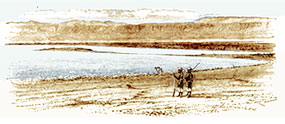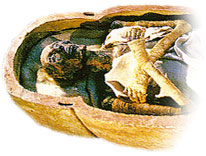|
"Then
the Lord rained upon Sodom and upon Gemorrah brimstone and fire
from the Lord out of heaven; and he overthrew those cities and
all the plain, and all the inhabitants of the cities, and that
which grew upon the ground. But [Lot's] wife looked back from
behind him, and she became a pillar of salt."
—
Genesis
19:25-26
|
The waters
of the Dead Sea contain 33% salt, an amount 10 times higher than is found
in the Mediterranean Sea. Salt mountains with cathedral-like salt-chimneys
and caves have formed around its perimeter. Ancient traditions that persist
to this day have held that Lot's wife exists permanently as one of the pillar-like
"salt mushrooms" that form on the Eastern shore of the Sea.[1]
Archaeologists have formed numerous speculations concerning the whereabouts
of the cursed cities of the plain Sodom and Gemorrah
based on the location of these salt pillars.

In addition
to salt, the Dead Sea contains many minerals and mineral compounds including
magnesium chloride, calcium chloride, potassium chloride, magnesium bromide,
and calcium sulfate. They are responsible for the variety in Dead Sea salt,
which has been obtained for millennia through mining and evaporation.
Several descriptions
that we have received from people visiting the Dead Sea during the Middle
Ages speak of salt as a food having many grades, from the rough and inedible
to refined and delicious.
The 10th
century Muslim physician Mohammed ben Ahmad Ben Said at-Tamimi describes cooking
salt of several different kinds that differed in purity, brittleness, and
color. Regarding the hard rock salt that was collected on the shore of the
Sea and eaten throughout the region, he writes, "In color it tends to
blue and not pure white, and its hardness is greater than that of mined salt."
At-Tamimi
also writes about an inedible, bitter salt that crystallized on the eastern
shore, as well as a pleasant-tasting white salt with no odor that was collected
at the south-eastern end of the Sea and farther north near Jerusalem, and
was eaten throughout Palestine.
Another type
of salt receives at-Tamimi's special attention, "And of the salt, there
is a variety known as 'andarani' and this is the salt called 'tabarzad'
in Iraq. People claim that it is imported from a village in al-Sham (Syria)
which is known by the name of Andara. It is bright white and it includes a
variety which is shiny and sticky."[2]
This Andarani
salt is also mentioned by the Rabbi Sa'adia Gaon (882-942), who identified
it with "Sodom salt" mentioned in the Talmud.
Another Muslim
writer living in the beginning of the 14th century writes:
"The
salt is from what is extracted from the soil and is of [several] kinds —
of which the Andarani is the whitest and finest and it comes from the Land
of Sodom near the sea of Lot. This is the way the rock it comes from breaks
— it does not break but crumbles into small crystals
which are squared at the corners. [Another kind is] the [sweet] salt which
is mixed with food — the best kind is the white
salt which has a pleasant smell, similar to that of the violet."[3]
 The
salt and minerals of the Dead Sea have been exploited for millennia. In addition
to providing an essential supply of salt to the inhabitants of the Middle
East, the lake was an important source of bitumen for the Egyptian mummifying
process, and a source of income for both King Herod and the Roman Empire —
both exported its mineral products. It has been suggested that Rome's extended
and difficult siege against the zealots on Masada in 73 CE was founded in
Rome's fear that Dead Sea salt and mineral production would be threatened
by Jewish insurgence.
The
salt and minerals of the Dead Sea have been exploited for millennia. In addition
to providing an essential supply of salt to the inhabitants of the Middle
East, the lake was an important source of bitumen for the Egyptian mummifying
process, and a source of income for both King Herod and the Roman Empire —
both exported its mineral products. It has been suggested that Rome's extended
and difficult siege against the zealots on Masada in 73 CE was founded in
Rome's fear that Dead Sea salt and mineral production would be threatened
by Jewish insurgence.
Early in
this century, a Siberian Jewish engineer named Moshe Novomeisky immigrated
to Palestine and lobbied the British to establish a potash and bromine plant.
The plant, which was called the Palestine Salt works, was built on the Northern
end of the lake in 1930. Four years later, a second plant for salt was built
on the southern end. The Palestine Salt Works was destroyed in the 1948 war
of Israeli Independence, but was reestablished, by the Israeli government,
in the 1950's as the Dead Sea Works. One of the industrial features the Dead
Sea Works has added to the Dead Sea landscape in recent years is a steep 18
kilometer conveyor belt for mined rock salt leading 900 meters up from Sodom,
the lowest point on earth, lying on the Southwest shore of the Dead Sea, up
to the railroad.
|
The
rich mineral content of the lake enables the Dead Sea Works to produce
several types and grades of salt that have many different purposes.
In addition to refined salt for food flavoring, the main types include:
Crude
Pan Salt, made from magnesium and calcium chlorides, which is used
in tanning, for road deicing and as an animal food additive. It is
moist, due to its mineral composition, reminiscent of at-Tamimi's
Andarani salt;
Potash,
a fertilizer containing large amounts of potassium chloride and other
mineral salts;
Magnesium
Chloride, a compound with many industrial uses including sewage treatment,
and sugar refining;
Potassium
Chloride, which is used to produce carageenan and gelatin, as well
as in electroplating, and in pharmaceutical products.
Perhaps
most well-known are the salts that are used in bathtubs and spas around
the world. They are 33% salt, and contain magnesium, potassium and
calcium chloride, in addition to a high concentration of bromides.

|
The Dead
Sea Works is one of several factors being blamed for the shocking lowering
of the lake's water level, which has fallen 80 feet in the last 40 years.
The plant's threat to air quality and to the delicate ecosystem of the area
are also great concerns of environmentalists. However, it is conceded that
the Dead Sea Works plants have spent considerable sums of money on preservation.
It is a strange fact that if not for the Dead Sea Works and its Jordanian
counterpart, the Arab Potash Company, there would be no "Dead Sea"
in the south. A number of resorts rely on the shore of the evaporation pools
to give their guests a Dead Sea experience. It is water from the Dead Sea,
and it is where the Dead Sea thrived less than 50 years ago, but technically,
it is no longer the Dead Sea itself.[4]
|
[1]
Barbara Kreiger, Living Waters: Myth, History, and Politics
of the Dead Sea (New York: Continuum, 1988), pp. 100-107.
[back]
[2]
Zohar Amar. "The Production of Salt and Sulfur from the Dead
Sea Region in the Tenth Century according to at-Tamimi."
Palestine Exploration Quarterly 130 (1998), p. 3. [back]
[3]
Amar, p.4. [back]
[4]
MSNBC "Dead Sea Reaching All Time Lows" July 26, 1999.
[back]
|
|
The
Dead Sea Works, http://www.dsw.co.il/ |
|
Thanks
to David Bloch for his wonderfully informative salt website, http://www.salt.org.il/main.htm |